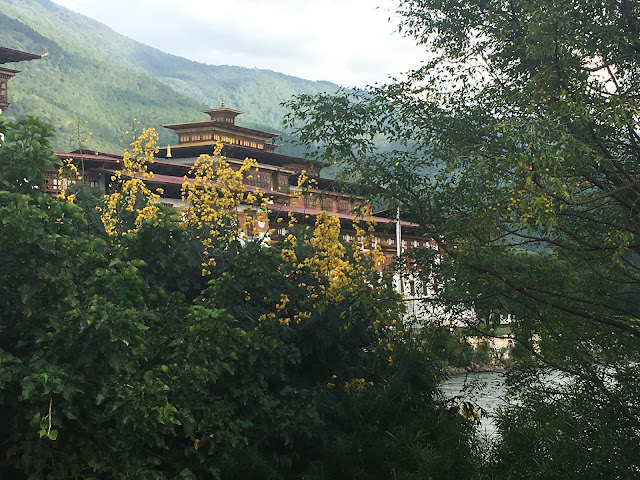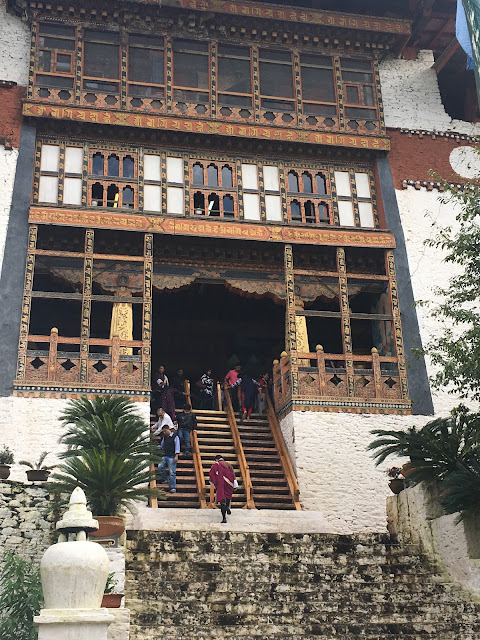
Finally, we'd arrived to Bhutan's capital city, Thimpu, for the Teschu Festival. We awoke to a light rain and were a little upset as it was the only day it had rained on our trip. We managed to get into our silk national-dress Kiras by 7 am to meet Tashi in our hotel lobby, the sleek four-star Terma Linka. Tashi is pictured in his best silk Goh, the men's national dress. He thought the guards wouldn't let us bring umbrellas into the ancient Fort where the dances were held and we contemplated what it was going to be like to sit out in the open getting soaked in our beautiful new Kiras. Of course we were game after coming all this way to see the dances but when we got to the fort the guards let us (and all the Bhutanese) watch comfortably under
umbrellas. We sat there from 8:30 to 12 noon so those umbrellas were a serious blessing. The dancers went on in the rain, something we Graham dancers didn't do when when we played open air theaters in the summers throughout Europe. We worried we would get injured and slip....not to mention it was forbidden by our AGMA union rules. Obviously, the Bhutanese people and dancers don't have an America Guild of Musical Artist union and are a hardy bunch. Their dances are close to the ground and there aren't any lifts, running, or quick movements so it did seem fairly easy, while probably uncomfortable, to dance in the rain. They danced on a stone surface with a green mat that defined their dance space.
This is an opening ceremony dance. All men.

The Unesco Heritage Dance called the Dance of the Black Hat. The dance on one level commemorates the killing of the anti-Buddhist Tibetan king Langdarma in 842 by the Buddhist monk Pelkyi Dorji. It also represents the transformation of the dancers into powerful tantric yogis, who take possession of the dancing area and drive out all the evil spirits as they stamp the ground. (These last two sentences from my Lonely Planet book.) Costumes are large brimmed black hats with long dresses made from brocade fabrics with aprons depicting the wrathful deities. There is a peacock feather that points upward out of their hats that help to pierce the evil spirits. The dancers keep arching backwards, chest to the sky, then roll their backs in a circle, twirling and lifting their legs in a large forward step. Three of the dancers do a counterpoint four beat lunge step - similar to the Graham low runs - and them stop abruptly, on the musical cue. The rest of the dancers pause while the three dancers lunge/run four times then they continue with their overall circular pattern while executing their back rolling bends, multiple turns, and heavy weighted skips. Their skirts fly around one way, collect, then they reverse the turn so that the skirt unwinds to open in the opposite direction. It makes a colorful display since their brocade costumes are all of different patterns and hues. This dance went on for forty-five minutes and I have no idea how they remembered the subtlety of the patterns that changed almost imperceptibly. While they looked like the same movements, they were slightly different as the dance progressed. This seemed to me much like a Steve Reich score that repeats musical phases and then evolves to greater intensity -- quietly, like a sunset.
It was clear that lots of rehearsal was necessary.
I was enthralled with the dances and the entire scene even as the rain continued. At times, someone's umbrella or a security guard would block our view, but we managed to get a second row seat and that helped. That's Tashi sitting next to me.
Folksongs are sung by the line of women dancers in between the main dances. Here the clowns are having a good time with the phallus placed in front of the women.
(click to enlarge so that you can see)
The phallus symbol is found throughout Bhutan and is sometimes painted on houses to ward off evil spirits and to provide protection.
Pictured here is the Unesco Heritage Dance called the Dance of the Black Hat with Drum. The Black Hat dancers came out again after the women did a folkdance song in a long line. This time the male dancers brought the drums and the movement patterns were somewhat the same as before except they beat the drums. It was another forty-five minute dance.
Mesmerizing! Exquisite.
Bhutanese young women happily dressed for the Teschu under umbrellas and
holding their iphones close.
The women brought rugs to place on the wet stone steps.
Bhutanese man in his silk Goh, complete with Nikki sneakers and backpack.
Every combination of brocade jackets and woven Kira skirts were individualistic.
Such variety was a dazzling display of femininity and refinement.
Here's Tashi, our wonderful guide, under the umbrella. He's the father of a two-year old daughter. His wife works in the immigration office in Thimpu. Their mothers alternate living with them for six months to help take care of their daughter while Tashi and his wife work.
Tashi didn't think we'd want to stay very long at the Teschu but he began to understand how much we loved it as we sat for hours in the rain.
Lunch at the Orchid Restaurant after a long wet morning at the Teschu, still in national dress. Very happy at the morning's dances and what we were able to witness.




















































